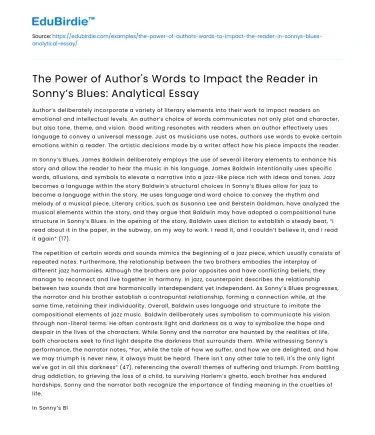Author’s deliberately incorporate a variety of literary elements into their work to impact readers on emotional and intellectual levels. An author’s choice of words communicates not only plot and character, but also tone, theme, and vision. Good writing resonates with readers when an author effectively uses language to convey a universal message. Just as musicians use notes, authors use words to evoke certain emotions within a reader. The artistic decisions made by a writer affect how his piece impacts the reader.
In Sonny’s Blues, James Baldwin deliberately employs the use of several literary elements to enhance his story and allow the reader to hear the music in his language. James Baldwin intentionally uses specific words, allusions, and symbols to elevate a narrative into a jazz-like piece rich with ideas and tones. Jazz becomes a language within the story Baldwin’s structural choices in Sonny’s Blues allow for jazz to become a language within the story. He uses language and word choice to convey the rhythm and melody of a musical piece. Literary critics, such as Susanna Lee and Berstein Goldman, have analyzed the musical elements within the story, and they argue that Baldwin may have adopted a compositional tune structure in Sonny’s Blues. In the opening of the story, Baldwin uses diction to establish a steady beat, “I read about it in the paper, in the subway, on my way to work. I read it, and I couldn’t believe it, and I read it again” (17).
Save your time!
We can take care of your essay
- Proper editing and formatting
- Free revision, title page, and bibliography
- Flexible prices and money-back guarantee
The repetition of certain words and sounds mimics the beginning of a jazz piece, which usually consists of repeated notes. Furthermore, the relationship between the two brothers embodies the interplay of different jazz harmonies. Although the brothers are polar opposites and have conflicting beliefs, they manage to reconnect and live together in harmony. In jazz, counterpoint describes the relationship between two sounds that are harmonically interdependent yet independent. As Sonny’s Blues progresses, the narrator and his brother establish a contrapuntal relationship, forming a connection while, at the same time, retaining their individuality. Overall, Baldwin uses language and structure to imitate the compositional elements of jazz music. Baldwin deliberately uses symbolism to communicate his vision through non-literal terms. He often contrasts light and darkness as a way to symbolize the hope and despair in the lives of the characters. While Sonny and the narrator are haunted by the realities of life, both characters seek to find light despite the darkness that surrounds them. While witnessing Sonny’s performance, the narrator notes, “For, while the tale of how we suffer, and how we are delighted, and how we may triumph is never new, it always must be heard. There isn't any other tale to tell, it's the only light we've got in all this darkness” (47), referencing the overall themes of suffering and triumph. From battling drug addiction, to grieving the loss of a child, to surviving Harlem’s ghetto, each brother has endured hardships. Sonny and the narrator both recognize the importance of finding meaning in the cruelties of life.
In Sonny’s Blues, Baldwin uses symbolism to illustrate how the insistent hope of salvation overpowers the haunting despair in the character’s lives. Since everyone undergoes hardships, Baldwin is able to emotionally impact the reader by alluding to the darkness in their life. Baldwin’s use of light and darkness to convey the inevitability of suffering enhances the story by making it more universal. Baldwin intentionally incorporates allusions to enhance his story. Authors typically use allusions to help provide the reader with a deeper understanding of the message. Throughout the story, Baldwin indirectly references the bible. The biblical allusions included in Sonny’s Blues impact the reader both emotionally and psychologically. After the narrator witnesses Sonny’s performance, he realizes that music is a part of Sonny. To signify this new understanding, he sends a drink over to him. After the girl delivers Sonny’s drink, the narrator notes, “For me, then, as they began to play again, it glowed and shook above my brother’s head like the very cup of trembling” (48), implying that Sonny is progressing toward salvation. In the bible, the cup of trembling is described as a cup filled with fury, suffering, and fear. Therefore, Sonny’s drinking from the cup illustrates the suffering he has endured. By giving Sonny the cup, the narrator is offering him the opportunity for redemption. Baldwin uses biblical allusions to help the reader interpret the complex brotherly relationship between Sonny and the narrator. In Sonny’s Blues, Baldwin deliberately utilizes allusions in the story to enhance the reader’s understanding of the plot and characters. James Baldwin intentionally includes numerous literary elements in Sonny’s Blues to enhance the story. He employs the use of symbolism so that the piece will resonate with readers while also incorporating biblical allusions to connect his story with someone else’s. Baldwin also structures the story in a way that resembles that of a musical composition. His word choice and language allow jazz to become a language within the story. The choices an author makes affect how their work will be interpreted by their audience. Therefore, authors incorporate various literary elements into their work to impact the reader both emotionally and psychologically.






 Stuck on your essay?
Stuck on your essay?

